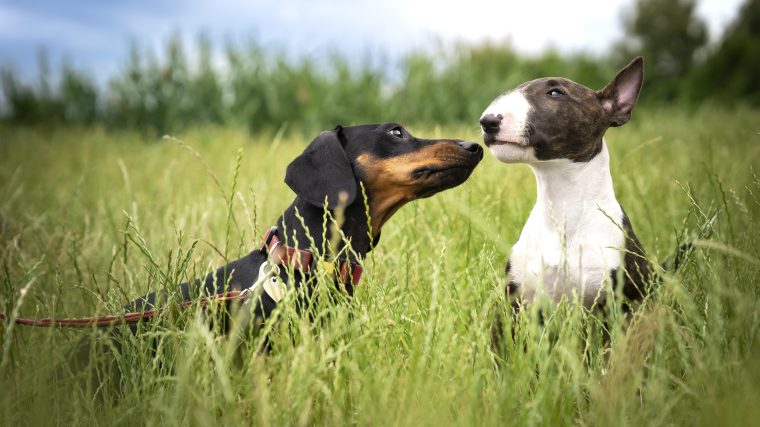
Sometimes, two dogs just don’t get along. Whether you’ve just adopted a second dog, or are struggling at the dog park, there are many reasons why a dog may have trouble adjusting. Learn more about what can cause this, and how to help dogs get along more easily.
Why don’t dogs get along?
There are a number of reasons why two dogs might not get along. Gender, spay or neuter status, breed, history, medical problems, and more can all affect how a dog feels about another. Underlying medical issues that cause pain or changes to how another dog smells can also affect greetings. Other factors, such as breeds that have cropped ears or tails, may hamper communication between dogs, leading to misunderstandings and potential problems.
A dog may also be wary or more protective of a location, such as the home or yard. In addition, behavioral issues such as barrier or leash aggression may cause a dog to act out when behind a fence or on leash, but otherwise be receptive to other dogs when out in the open.
Some dogs may have also had bad experiences in the past. If your dog was attacked at a dog park by another dog, your dog may be more wary of dogs that look or act similarly. Or, they may associate the location with the trauma, causing them to be on extra alert.
How to help your dogs get along
A short first meeting in a neutral and calm location is the best way to get started. Avoid places such as the yard or your home where there may be disputes over toys or territory. From there, have the two dogs meet each other while monitoring their body language. You’ll want to watch for signs of stress such as a tucked tail, stiff body, direct staring, and low growls or hackling. If you notice this, it’s time to stop the meeting and try again later. Be sure to give both dogs some time to cool off and relax.
Once your dogs are OK with short meetings, you can gradually increase the time they spend together. This can be a short walk through the neighborhood or a move into the home or yard if both dogs seem comfortable. You’ll want to continue to monitor both dogs as they play or interact, and be sure to give each dog a chance to settle down if they get too excited or rough when playing.
When to seek professional advice
Sometimes, meeting another dog is just a little too scary or stressful. If you notice your dog is very reactive around others, it’s best to seek out professional help from a trainer or behaviorist in your area. This will help avoid any extra stress or potential fights.
Training also offers a large range of solutions depending on your dog’s needs. For the basics, group classes are a great way to teach your dog how to safely interact with others (and listen to you) in a controlled setting. For more reactive or wary dogs, one-on-one sessions with techniques such as behavioral adjustment training can help your dog feel calmer around other dogs.
If you’re considering adding another dog to your household, be sure to check out some of the most dog-friendly breeds out there. It may seem stressful to help dogs get along, but the social benefits for your dog can be rewarding!









